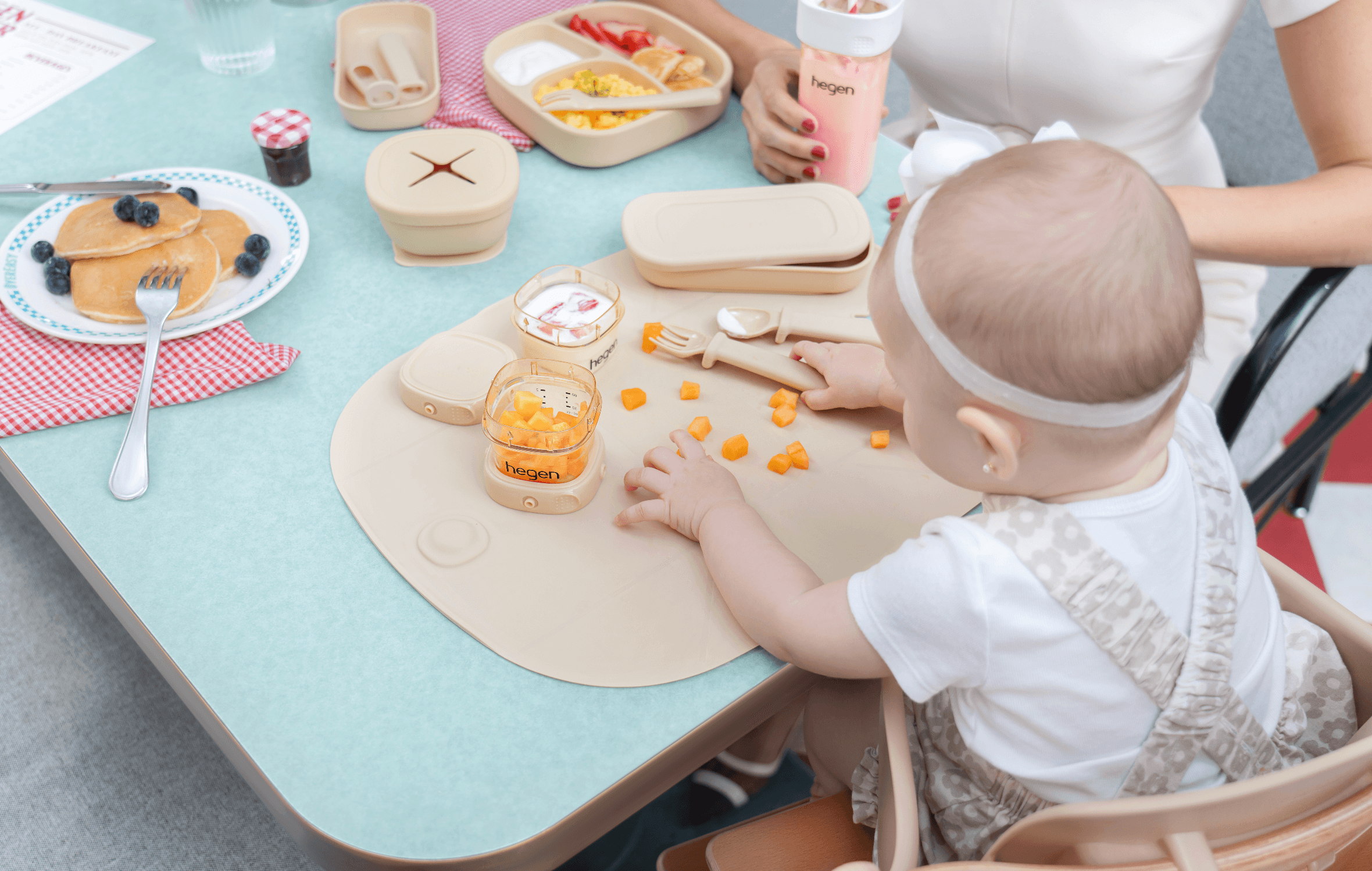Transitioning your baby to solid foods marks a significant milestone in parenting. By the time your little one hits the 6-month mark, you’ve likely got breastfeeding or bottle-feeding down to a science. But as with all things in parenthood, change is on the horizon! Your baby is ready to explore the world of solid foods, creating opportunities for delightful bonding experiences over mealtimes. With the right guidance and innovative baby feeding essentials from our new Mealtime Collection, you can transform weaning into a joyous adventure for both you and your child. Here’s everything you need to know to embark on this exciting journey.
When to start weaning your baby
Weaning, the gradual introduction of solid foods alongside continued breast milk or formula, is a crucial phase in your child’s development. It equips them with the skills needed for eating solid foods and provides essential nutrients beyond what milk alone can offer.
Most experts suggest beginning weaning around six months, with KK Women’s and Children’s Hospital (KKH) advising not to start earlier than four months. During this process, breast milk or formula remains the primary nutrition source until your baby turns one. Keep an eye out for these signs indicating your baby might be ready for solids:
- Sitting up with minimal support: Your baby should be able to sit upright and hold their head steady.
- Showing interest in food: If your baby starts reaching for your food or watches intently as you eat, it might be time to introduce solids.
- Losing the tongue-thrust reflex: This reflex, which pushes food out of your baby's mouth, usually disappears around six months.
Always consult your paediatrician before starting weaning to ensure your baby is ready and to address any concerns you may have.
Different methods for weaning
There are various approaches to weaning, each with its own benefits and challenges. Let’s explore two popular methods, Traditional Weaning and Baby-Led Weaning (BLW).
Traditional Weaning
This method involves spoon-feeding your baby and gradually introducing more solid foods. It typically starts with smooth purees and progresses to mashed, chopped, finger foods and small bites.
Benefits:
- Controlled Portions: Parents can measure and control the amount of food their baby consumes, making it easier to track nutritional intake and identify any potential allergies.
- Gradual Texture Changes: This method helps babies gradually adjust from smooth purees to more complex textures, reducing the risk of choking and making it easier for babies to learn to chew.
- Minimises Mess: Spoon-feeding tends to be less messy compared to self-feeding, as parents can guide the food directly into the baby’s mouth, reducing spills and clean-up time.
Challenges:
- Longer Preparation Time: Preparing purees can be time-consuming as it requires caregivers to blend and mash foods regularly.
- Texture Dependency: Babies might become accustomed to the smooth texture of purees and resist transitioning to more solid foods later on.
Baby-Led Weaning (BLW)
BLW encourages babies to self-feed from the beginning, allowing them to explore foods at their own pace using their hands.
Benefits:
- Encourages Independence: Babies learn to control their own food intake, promoting autonomy and decision-making skills.
- Develops Fine Motor Skills: Handling different food shapes and textures help improve hand-eye coordination and dexterity.
- Fosters Togetherness: Babies eat the same foods as the rest of the family, which can make mealtime more inclusive and enjoyable while encouraging healthy eating habits.
Challenges:
- Messier Mealtimes: BLW allows your little one to explore food at their own pace, which means making a mess at nearly every meal!
- Potential Choking Risk: There may be a higher risk of choking if foods are not appropriately sized or if babies are not closely supervised.
- Harder To Track: It can be harder to determine exactly how much food your child is consuming, making it challenging to monitor their nutritional intake.
Can’t decide? You don’t have to choose just one method! Feel free to combine elements of both to suit your baby’s needs and your family’s preferences.
Tips for weaning success
Ready to introduce solids? Here are some tips to ease the process:
Start with simple, single-ingredient foods
Begin weaning with easy-to-grasp, soft foods. Here are some suggestions:
- Fruits: Mashed bananas, pears or avocados.
- Vegetables: Steamed carrots, sweet potatoes or peas.
- Single-Grain Baby Cereals: Mix with breast milk or formula for added nutrition.
Prepare these foods by mashing or steaming until they are soft enough for your baby to handle. For baby-led weaning, make sure all food is cut into appropriate sizes to prevent choking. Supervise your baby during meals and avoid giving foods that pose a choking risk, such as whole grapes or large chunks of meat.
😋🍽️ Check out our Weaning Food Guide (Recipes) here.
Watch out for allergies
According to paediatrician Dr Ratna Sridjaja from Mount Elizabeth Hospital, you shouldn’t avoid giving your baby foods that are common allergy culprits like peanuts, eggs and shellfish. Instead, monitor your baby closely the first few times they try these foods and wait for three to five days before introducing another new food. If you notice any signs of an allergy, such as rashes or difficulty breathing, contact your paediatrician immediately.
Choose the right feeding tools
Opt for safe, food-grade materials like silicone, such as those used in Hegen’s feeding utensils. You’ll also want to avoid potentially harmful substances like BPA, a chemical used in some plastics. Dr Ben Ng, an endocrinologist at Mount Elizabeth Novena Specialist Centre explains there is a worry that “long-term exposure [to BPA] can affect children’s growth.” Reassuringly, all Hegen products are free of BPA, BPS, Phthalate and PVC.
Here are other key features to consider:
- Non-Slip Tableware: Perfect for curious infants and tots, suction bowls and plates help minimise spills, making mealtimes less messy and more manageable.
- Sectioned Plates: Their compartments help balance meals and make them visually appealing, allowing your little one to identify and explore various foods.
- Cleaning Methods: Look out for materials that dishwasher safe or easy to clean by hand. Silicone products, for instance, are often resistant to odours and stains, making them a breeze to clean.
- Baby-Friendly Design: Choose utensils with thick handles and good grips to make them easy for infants to hold and control.
Be Patient
It may take a few attempts before your baby accepts a new food. Pressure from caregivers may negatively impact their willingness to try new foods, so try to stay calm and patient.
Introducing Hegen’s Mealtime Collection
As you embark on your weaning journey, Hegen offers a range of innovative products designed to simplify mealtimes and enhance bonding for you and your baby. Here are some weaning essentials from our new Mealtime Collection:
- Suction Bowls & Plates
Crafted from food-grade silicone, Hegen Suction Bowl Silicone with Snack Lid Taupe ensures secure feeding and snacking anywhere you go. Simply snap on the snack lid to transform the bowl into a snack cup or a water bath.
Ideal for baby-led weaning, the ergonomically designed Hegen Divided Suction Plate Silicone Taupe comes with compartments to promote a well-balanced meal while encouraging self-feeding. Plus, its deep inner walls and rounded corners making scooping easier for your child, fostering independence during mealtimes.
- Kids Cutlery
Featuring a narrow head for easy feeding and a long handle for a secure grip, the soft-tipped Hegen Infant Spoon Silicone Taupe is perfect for traditional weaning. Made from food-grade silicone, it ensures safe and comfortable feeding for your little one.
For baby-led weaning, try our Hegen Multi-stage Fork and Spoon PPSU with Case Taupe, which allows your tot to practise self-feeding with utensils designed for small hands. The innovative design evolves with your child from 6 months to 3 years and beyond – as they grow older, they can take off the removable silicone grip for independent feeding, while the PPSU material ensures durability through all their growth stages.
- All-In-One Baby Feeding Set
A portable, all-in-one baby weaning set can make feeding on the go so much simpler. Our Hegen Mealtime Starter Kit with Foldable Placemat Taupe (Set) comes with a non-slip, BPA-free placemat that unfolds easily to create a tidy feeding spot while minimising mess. It includes two Hegen PCTO™ 60ml/2oz Breast Milk Storage PPSU containers and the Hegen Multi-stage Fork and Spoon PPSU with Case to ensure you’re prepared for mealtime, anytime and anywhere. With this hassle-free weaning kit, you can focus on enjoying a delightful dining experience with your child.
With the right approach and tools, weaning can be a rewarding and enjoyable experience for both you and your baby. Our new Mealtime Collection is designed to support you through this exciting phase, making the transition to solids smoother and more enjoyable. Explore the new mealtime feeding range today to begin your weaning journey with confidence and joy.





